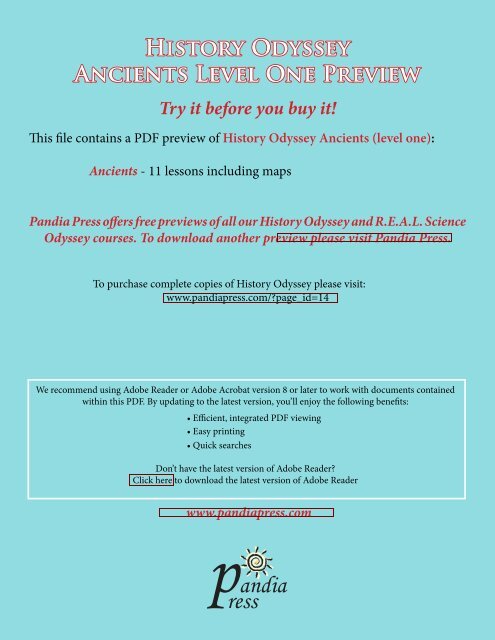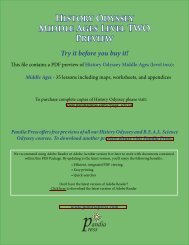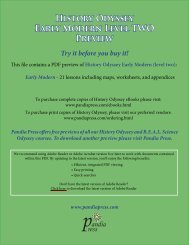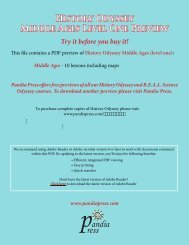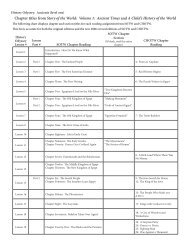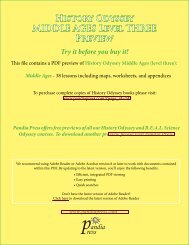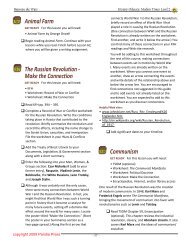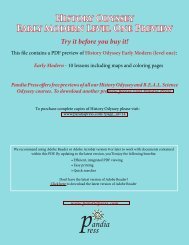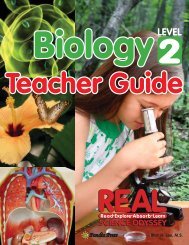History Odyssey - Ancients (level one) eBook Preview - Pandia Press
History Odyssey - Ancients (level one) eBook Preview - Pandia Press
History Odyssey - Ancients (level one) eBook Preview - Pandia Press
Create successful ePaper yourself
Turn your PDF publications into a flip-book with our unique Google optimized e-Paper software.
<strong>History</strong> <strong>Odyssey</strong><br />
<strong>Ancients</strong> Level One <strong>Preview</strong><br />
Try it before you buy it!<br />
This file contains a PDF preview of <strong>History</strong> <strong>Odyssey</strong> <strong>Ancients</strong> (<strong>level</strong> <strong>one</strong>):<br />
<strong>Ancients</strong> - 11 lessons including maps<br />
<strong>Pandia</strong> <strong>Press</strong> offers free previews of all our <strong>History</strong> <strong>Odyssey</strong> and R.E.A.L. Science<br />
<strong>Odyssey</strong> courses. To download another preview please visit <strong>Pandia</strong> <strong>Press</strong>.<br />
To purchase complete copies of <strong>History</strong> <strong>Odyssey</strong> please visit:<br />
www.pandiapress.com/?page_id=14<br />
We recommend using Adobe Reader or Adobe Acrobat version 8 or later to work with documents contained<br />
within this PDF. By updating to the latest version, you’ll enjoy the following benefits:<br />
• Efficient, integrated PDF viewing<br />
• Easy printing<br />
• Quick searches<br />
Don’t have the latest version of Adobe Reader?<br />
Click here to download the latest version of Adobe Reader<br />
www.pandiapress.com<br />
pandia<br />
ress
HISTORY ODYSSEY<br />
ANCIENTS<br />
PREVIEW<br />
AN ACTIVITY-BASED<br />
STUDY GUIDE COMBINING<br />
HISTORY<br />
GEOGRAPHY<br />
READING<br />
WRITTEN BY<br />
CATHY WHITFIELD<br />
LEVEL ONE
<strong>History</strong> <strong>Odyssey</strong><br />
<strong>Ancients</strong><br />
(<strong>level</strong> <strong>one</strong>)<br />
PREVIEW<br />
To purchase a print copy of HO <strong>Ancients</strong> (<strong>level</strong> <strong>one</strong>) please visit:<br />
www.pandiapress.com/?page_id=14<br />
Cathy Whitfield<br />
<strong>Pandia</strong> <strong>Press</strong>
Copyright © <strong>Pandia</strong> <strong>Press</strong><br />
All Rights Reserved<br />
Without limiting the rights under copyright reserved above, no part of this publication may be reproduced,<br />
stored in or introduced into a retrieval system, or transmitted, in any form, nor by any means (electronic,<br />
mechanical, photocopying, recording, or otherwise), without the prior written permission of <strong>Pandia</strong> <strong>Press</strong>. The<br />
purchaser of this study guide may print maps and coloring pages for use with their children. Printing<br />
for group, co-op, classroom, or school use is prohibited. Contact <strong>Pandia</strong> <strong>Press</strong> for information about group,<br />
school, and co-op licensing.<br />
Published by<br />
<strong>Pandia</strong> Pre<br />
, FL<br />
Visit www.pandiapress.com for ordering information and sample pages of <strong>Pandia</strong> <strong>Press</strong> publications.
Table of Contents<br />
Letter to Parents and Teachers 5<br />
How to Use This Guide 5<br />
Suggested Weekly Schedule 9<br />
Lesson 1 Learning About the Past 11<br />
Lesson 2 The Move From Caves to Towns 12<br />
Lesson 3 The Sumerians 14<br />
Lesson 4 First Writings 16<br />
Lesson 5 The Egyptians 17<br />
Lesson 6 Egyptian Religion: Mummies and Gods 19<br />
Lesson 7 Egyptian Pyramids 21<br />
Lesson 8 Indus Valley 22<br />
Lesson 9 Europe Builds Monuments 23<br />
Lesson 10 Ancient Crete 24<br />
Lesson 11 The Mycenaeans 25<br />
Lesson 12 The Babylonians and the Hittites 26<br />
Lesson 13 Egypt’s Empire 27<br />
Lesson 14 Daily Life of the Egyptians 29<br />
Lesson 15 Canaanites - Philistines - Hebrews 31<br />
Lesson 16 The Phoenicians 33<br />
Lesson 17 The Assyrians 34<br />
Lesson 18 Babylon Returns 35<br />
Lesson 19 The Persians 36
Lesson 20 Ancient Greece 37<br />
Lesson 21 Daily Life in Ancient Greece 39<br />
Lesson 22 Alexander the Great 41<br />
Lesson 23 The Scythians 42<br />
Lesson 24 Between the Rivers - Ancient China 42<br />
Lesson 25 Later in Ancient China 44<br />
Lesson 26 Ancient Africa 46<br />
Lesson 27 Ancient India 48<br />
Lesson 28 Look What’s Happening in America 49<br />
Lesson 29 The Celts 50<br />
Lesson 30 The Rise of Rome and Its Wars 51<br />
Lesson 31 Daily Life in Ancient Rome 53<br />
Lesson 32 The Spread of Christianity 55<br />
Lesson 33 Rome Falls to the Barbarians 56<br />
Lesson 34 Byzantine Empire 57<br />
Lesson 35 Make Your Ancient <strong>History</strong> Keepsake Book! 58<br />
Map 1 - The Fertile Crescent 59<br />
Map 2 - Ancient Egypt 60<br />
Map 3 - The Indus Valley 61<br />
Map 4 - Ancient Greece 62<br />
Map 5 - The Babylonian and Hittite Empires 63<br />
Map 6 - The Egyptian Empire 64<br />
Map 7 - The Phoenicians 65<br />
Map 8 - The Assyrian Empire 66<br />
Map 9 - The Babylonian Empire - Again! 67<br />
Map 10 - The Persian Empire 68<br />
Map 11 - The Empire of Alexander the Great 69<br />
Map 12 - Ancient China 70<br />
Map 13 - Ancient Africa 71<br />
Map 14 - Ancient India 72<br />
Map 15 - Ancient Americas 73<br />
Map 16 - The Gre at Roma n E mpi re 74
Letter to Parents and Teachers<br />
Th ank you for purchasing this <strong>History</strong> <strong>Odyssey</strong> study guide. If you are familiar with a classical approach to history,<br />
you know your child will be spending the next school year immersed in the wonderful story of early modern<br />
history. If this is your first time using <strong>History</strong> <strong>Odyssey</strong>, take the time to read through these introductory pages,<br />
gather materials and work out a schedule for history based on your child’s abilities. <strong>History</strong> <strong>Odyssey</strong> provides the<br />
structure and framework for using and organizing many of the best resources available for the study of mankind.<br />
This is not a textbook approach! If you or your child would rather take a fill-in-the-blanks workbook approach to<br />
history, then there are plenty of those curricula available. <strong>History</strong> <strong>Odyssey</strong>’s unique approach for this age group<br />
is <strong>one</strong> that encompasses literature, activities, and geography. As your child progresses through this guide, he or<br />
she will be learning about ancient history through reading many of the best books written about this time period.<br />
Your child will be learning geography and be engaged in exciting activities. <strong>History</strong> <strong>Odyssey</strong> presents history in<br />
a way that is exciting and memorable. Most parents and teachers find themselves wishing they had been taught<br />
history this way. So don’t be surprised if you find yourself learning and having fun right along with your child or<br />
student!<br />
How to Use This Guide<br />
Adapting for Different Levels<br />
These lesson plans are written for a student who is in the grammar stage of a classical education or in the first,<br />
second, third, or fourth grade (approximately 6-10 years old). That is a big span. There can a tremendous reading<br />
and comprehension skill discrepancy between a typical first- and fourth-grade student. These plans have been<br />
carefully formulated to provide material to meet the needs of all grammar-stage students no matter what their <strong>level</strong><br />
or ability. Here are some further suggestions for adapting these plans for students at either end of the spectrum:<br />
Advanced Level (independent reader) -<br />
Independently read books or read aloud to the group<br />
Heavy focus on map work<br />
Add resources (especially whole books and classic literature)<br />
<strong>History</strong> lessons three times per week (use the third lesson for further research or independent reading)<br />
Outline lessons or write summaries<br />
Beginning Level (not reading independently) -<br />
Read books to the child<br />
Less focus on map work<br />
More focus on coloring and activities<br />
<strong>History</strong> lessons <strong>one</strong> or two times per week<br />
Have child copy or dictate summary sentences and dictionary words<br />
5
Sequence<br />
In a classical education, history is studied chronologically. Ideally, a student will study the entire history of mankind<br />
over a four-year period three separate times, each time building on their knowledge.<br />
1st grade, 5th grade, and 9th grade -<br />
2nd grade, 6th grade, and 10th grade -<br />
3rd grade, 7th grade, and 11th grade -<br />
4th grade, 8th grade, and 12th grade -<br />
Ancient <strong>History</strong><br />
The Middle Ages<br />
Early Modern<br />
Modern <strong>History</strong><br />
However, it has been our experience that many students are unable to follow this schedule exactly from first through<br />
twelfth grade. Don’t worry if your child or student has to miss a period of history in <strong>one</strong> or more of the stages of<br />
education. He has three times to learn it! What is important is that your student is building on knowledge in a<br />
sequential way and is enjoying history.<br />
Required Resources<br />
Main Reference Spine: The Usborne Internet-Linked Encyclopedia of World <strong>History</strong><br />
Optional Additional Reference Spine: A Child’s <strong>History</strong> of the World by Virgil M. Hillyer (Calvert Educational<br />
Services)<br />
Books and Resources for Ancient <strong>History</strong>:<br />
The Story of the World, Volume 1: Ancient Times by Susan Wise Bauer (Peace Hill <strong>Press</strong>, 2001, 2006)<br />
<strong>History</strong> Pockets: Ancient Civilizations (Evan-Moor, 2003)<br />
Ancient Egyptians and Their Neighbors by Marian Broida (Chicago Review <strong>Press</strong>, 1999)<br />
Ancient Israelites and Their Neighbors by Marian Broida (Chicago Review <strong>Press</strong>, 2003)<br />
Life in Ancient Greece Coloring Book by John Green (Dover Publications, 1993)<br />
Life in Ancient Rome Coloring Book by John Green (Dover Publications, 1997)<br />
Additional Resources and Activities<br />
Each lesson contains an additional reading list to allow students to research a topic further and to provide resources<br />
to meet the needs of students with varying abilities. Most can be found at your local library. In addition to the<br />
required resources listed above, you will need a world map or globe, a three-ring notebook or folder for each student<br />
to store his work, blank paper, simple art supplies, and a children’s dictionary. We recommend Webster’s New World<br />
Children’s Dictionary, 2nd Edition (Hungry Minds, 1999), but any good dictionary will work. You will also want<br />
to have a three-hole punch and a camera handy.<br />
Writing Assignments<br />
The writing activities in this guide consist of dictionary work. We suggest older students also write a short summary<br />
of each lesson in their notebooks. You could have your child either write each summary, copy it, or dictate<br />
to you depending on his skill <strong>level</strong>. Copying sentences helps young children learn spelling, punctuation, and basic<br />
grammar. It will help prepare them for writing their own sentences.<br />
6
<strong>History</strong> Notebook<br />
Your child will need a place to keep their written work, map work, <strong>History</strong> Pockets, and coloring pages while<br />
completing this course. We recommend having a designated history folder or a three-ring binder for this purpose.<br />
All work that is collected will be used to construct an Ancient <strong>History</strong> Keepsake Book at the end of the course.<br />
Activities: Projects, Coloring Pages, <strong>History</strong> Pockets Books, and Maps<br />
The activities in this guide include coloring pages, activity projects, <strong>History</strong> Pockets books, and map work. These<br />
activities provide hands-on learning experiences, and we highly recommend that you attempt to complete most<br />
of them.<br />
Maps - There are sixteen maps included in this course. The maps provide an opportunity to learn ancient and<br />
modern-day world geography. Map work includes simple labeling, coloring, and completing map keys. Your child<br />
will need a detailed wall map or globe to complete the maps. When labeling and coloring maps, use colored pencils<br />
or crayons. Markers tend to bleed through and blot out labels.<br />
Coloring Pages - The coloring pages for this course are found in the Life in Ancient Greece Coloring Book and Life<br />
in Ancient Rome. The course instructions indicate the appropriate time for each coloring page. The best way to<br />
incorporate the coloring pages is to have your child color the corresponding page while you are reading aloud.<br />
Projects - The projects in this course are found in Ancient Egyptians and Their Neighbors, Ancient Israelites and<br />
Their Neighbors, and <strong>History</strong> Pockets: Ancient Civilizations. We tried to list many hands-on projects in this lesson<br />
plan with the intention that you will pick the <strong>one</strong>s that will most interest your student. Consequently, in many<br />
lessons there are more projects listed than would be practical to do. Remember as you go along to take pictures of<br />
the projects for the Ancient <strong>History</strong> Keepsake Book in the final lesson.<br />
Lessons<br />
In each lesson you will do several of the following:<br />
Read from the Usborne Internet-Linked Encyclopedia of World <strong>History</strong> (hereafter abbreviated UILE)<br />
Read from The Story of the World, Volume 1 (hereafter abbreviated SOTW)<br />
Read from A Child’s <strong>History</strong> of the World (hereafter abbreviated CHOTW)<br />
Writing activities<br />
Projects<br />
Create coloring pages<br />
Label and color the map and look at a globe or wall map.<br />
Create a <strong>History</strong> Pockets projects<br />
Read from the suggested book list or find additional books on your own.<br />
These plans are based on a full school year of history studies. Many lessons contain <strong>one</strong> or more parts. Each<br />
part may take about a week to complete. In some lessons you will find an abundance of information and you will<br />
want to take two or more weeks for these lessons. This study guide is written to include as much information as<br />
possible. Since every family has a different schooling style, these lesson plans are designed to be as flexible as possible.<br />
When a concept interests your child, use the book list or look up that topic at your library. Bring the book<br />
list from the next two lessons with you to the library to avoid having to scramble for resources. Reading at least<br />
7
<strong>one</strong> additional book from the book list per lesson is recommended, or more if your child is interested. At the end<br />
of this study guide, you will be assisting your child in compiling her work into an Ancient <strong>History</strong> Keepsake Book.<br />
It will be a wonderful keepsake for her. She can show her family and friends all she learned about early modern<br />
history.<br />
Helpful Hints<br />
Depending on your child’s reading <strong>level</strong>, you can either read to him, have him read aloud to you, or have him<br />
read independently. If your child is a mover, try having him color a coloring page while you read. Each child is<br />
different; find what works best for yours. Remember, just because a child is moving does not mean he is not listening.<br />
Many lessons require gathering of project materials and making copies. The intention is that you will go over<br />
these a few days prior to the lesson to ensure you have all of the necessary materials. The <strong>History</strong> Pocket book<br />
requires that you copy several pages for each pocket. We suggest that you take the book to a copy center and make<br />
all of the necessary copies at <strong>one</strong> time.<br />
You will notice that some lessons overlap in time period. You may also notice that SOTW, UILE, and CHOTW<br />
follow a somewhat different chronological order. Therefore, the reading assignments will be scattered throughout<br />
these books and do not always follow the order as presented in these books. You may want to flip back in SOTW<br />
or CHOTW if the chapter you are reading makes reference to the previous <strong>one</strong>. (Generally only the first sentence<br />
or two refers to the previous chapter.)<br />
8
Suggested Weekly Schedule<br />
Week Start Date Lesson Books, Supplies, & Preparation<br />
1 #1 Learning About the Past<br />
2 #2 The Move From Caves to Towns - Part 1<br />
3 #2 The Move From Caves to Towns - Part 2<br />
4 #3 The Sumerians - Part 1<br />
5 #3 The Sumerians - Part 2<br />
6 #4 First Writings<br />
7 #5 The Egyptians<br />
8 #6 Egyptian Religion: Mummies and Gods<br />
(parts 1 and 2)<br />
9 #7 Egyptian Pyramids<br />
10 #8 Indus Valley<br />
11 #9 Europe Builds Monuments<br />
#10 Ancient Crete<br />
12 #11 The Mycenaeans<br />
13 #12 The Babylonians and the Hittites<br />
14 #13 Egypt’s Empire<br />
15 #14 Daily Life of the Egyptians<br />
16 #15 Canaanites - Philistines - Hebrews<br />
(part 1)<br />
17 #15 Canaanites - Philistines - Hebrews<br />
(part 2)<br />
18 #16 The Phoenicians<br />
19 #17 The Assyrians<br />
9
Week Start Date Lesson Books, Supplies, & Preparation<br />
20 #18 Babylon Returns<br />
21 #19 The Persians<br />
22 #20 Ancient Greece<br />
23 #21 Daily Life in Ancient Greece (part 1)<br />
24 #21 Daily Life in Ancient Greece (part 2)<br />
25 #22 Alexander the Great<br />
26 #23 The Scythians<br />
#24 Between the Rivers - Ancient China<br />
27 #25 Later In Ancient China<br />
28 #26 Ancient Africa<br />
29 #27 Ancient India<br />
30 #28 Look What’s Happening in America<br />
#29 The Celts<br />
31 #30 The Rise of Rome and Its Wars (part 1)<br />
32 #30 The Rise of Rome and Its Wars (part 2)<br />
33 #31 Daily Life in Ancient Rome<br />
34 #32 The Spread of Christianity<br />
#33 Rome Falls to the Barbarians<br />
35 #34 Byzantine Empire<br />
36<br />
#35 Make Your Ancient <strong>History</strong> Keepsake Book!<br />
10
Date: ________________<br />
Lesson 1 Learning About the Past<br />
Although it is outside the scope of these lesson plans, you may, depending on your beliefs, want to begin<br />
your study of the history of mankind with a study of Biblical creation, evolution, or both. You may want to also<br />
include a study of the creation stories of other religions and cultures. The first part of UILE and the first two<br />
chapters of CHOTW contain prehistory information. A good book that includes many creation stories from<br />
ancient civilizations (including Egypt, Babylonia, Greece, Africa, China, India, and America) is Marduk the<br />
Mighty and Other Stories of Creation by Andrew Matthews (The Millbrook <strong>Press</strong>, 1997, ISBN: 0761302042).<br />
Another great book that is referenced throughout these lesson plans is Amazing Mythology: A Book of Answers<br />
for Kids by Brendan January (John Wiley & Sons, 2000, ISBN 0471332054).<br />
Prep for Lesson 1<br />
☐<br />
Copy pages 3, 5, 7, 8, 9, 11, 13, 15, and 16 in your Evan-Moor <strong>History</strong> Pockets: Ancient Civilizations book.<br />
One copy of each page per child.<br />
Main Lesson<br />
☐<br />
Complete Pocket 1, “What is <strong>History</strong>?” in your <strong>History</strong> Pockets book. (See page 4 for directions.) If you<br />
three-hole-punch the pockets, these can also be placed in your history notebook until all pockets are complete.<br />
☐ Read SOTW Introduction: How Do We Know What Happened?<br />
☐ Use a children’s dictionary and help your child look up and define archaeology. Be sure to place this copy<br />
work in your child’s history notebook.<br />
☐<br />
Draw and color a picture about what was read in this lesson. Hints: tree ring, buried b<strong>one</strong>s with an archaeologist<br />
digging them up, or a family tree.<br />
☐ If you have Internet access, don’t forget to use the Web site offered in UILE on pages 200 - 201 with each<br />
lesson in this study guide. Once at the site, follow the directions on page 200, and click on the Encyclopedia<br />
of World <strong>History</strong> link. This will bring you to a page where you can type in the page number (in UILE) you are<br />
studying at the moment. Once you do this and click “Find Links,” you will be directed to a page with links and<br />
other useful information for the time and area you are studying.<br />
Book List<br />
Archaeologists Dig for Clues by Kate Duke (HarperCollins, 1997) ISBN 0064451755. A wonderfully illustrated<br />
book about a group of kids who are shown an archaeological dig and are told all about being an archaeologist.<br />
Highly recommended.<br />
Right Here on this Spot by Sharon Hart Addy (Houghton Mifflin, 1999) ISBN 0395730910<br />
Eyewitness Books: Archeology by Jan McIntosh (DK Pub., 1994) ISBN 0679965726<br />
I Can Be An Archaeologist by Robert B. Pickering (Children’s <strong>Press</strong>, 1997) ISBN 0516019090. Although a book<br />
for older children, it has live pictures and large print.<br />
Discovering the Iceman by Shelley Tanaka (Hyperion Books, 1996) ISBN 0786802847. Some of the pictures are<br />
graphic, but a good book.<br />
11
Date: ________________<br />
Main Lesson Part 1<br />
☐<br />
☐<br />
Lesson 2 The Move from Caves to Towns<br />
Read UILE pages 108 -109. (Remember to discuss pictures as you read.)<br />
On Map 1, “The Fertile Crescent,” have your child label these seas: Mediterranean Sea, Red Sea, Caspian<br />
Sea, and the Persian Gulf. Also have him trace the Tigris, Euphrates, and Nile Rivers in blue. Shade the Fertile<br />
Crescent green (within the dotted lines). Complete the map key. You may want to do the labeling if your child<br />
cannot write small enough. See if your child can locate this area on a current globe or wall map. Point out to<br />
your child that most of this area is located in what we now call the Middle East. Much of the ancient history he<br />
will be studying takes place in this area. Show him how far it is from the Middle East to where he lives. (Each<br />
time you complete a map in this course, follow this same procedure—compare the completed map to a modernday<br />
map and see how far the area is from where you live.)<br />
☐<br />
Use a children’s dictionary and help your child look up and define tribe. Be sure to place this copy work in<br />
your child’s history notebook.<br />
☐ Draw and color a picture about what was read in this lesson. Hints: people living in a cave, tents or a city, or<br />
some<strong>one</strong> farming a field of wheat.<br />
Main Lesson Part 2<br />
☐<br />
☐<br />
☐<br />
Read UILE pages 120 - 121. (Remember to discuss pictures as you read.)<br />
Read SOTW Chapter One: The Earliest People.<br />
Read CHOTW Chapter 4: From an Airplane.<br />
☐ Again on Map 1, ask your child if he can locate the two towns you just read about (Jericho and Çatal<br />
Hüyük) and circle them in red.<br />
☐<br />
Use a children’s dictionary and help your child look up and define town. Be sure to place this copy work in<br />
your child’s history notebook.<br />
Book list<br />
Sunset of the Sabertooth (Magic Tree House #7) by Mary Pope Osborne (Random House, 1996)<br />
ISBN 0679863737. Mary Pope Osborne’s books are highly recommended.<br />
Living in Prehistoric Times (Usborne First <strong>History</strong>) by Jane Chisholm (Usborne Publishing, 1987)<br />
ISBN 0860206238<br />
Journey Through <strong>History</strong>: Prehistory to Egypt by Gloria and Oriol Vergés (Barron’s Educational Series, 1988)<br />
ISBN 0812033906<br />
Your Mother Was a Neanderthal (Time Warp Trio #4) by Jon Scieszka (Viking <strong>Press</strong>, 1993) ISBN 0670844810<br />
A funny series of books about a group of three boys who go back in time.<br />
How Do We Know Where People Came From? by Mike Corbishley (Steck-Vaughn, 1995) ISBN 0811438805<br />
The Cave Painter of Lascaux (Journey Through Time) by Roberta Angeletti (Oxford <strong>Press</strong>, 1999)<br />
ISBN 0195215583<br />
12
Fossils Tell of Long Ago by Aliki (Thomas Y. Crowell, 1990) ISBN 0690048440<br />
Ug by Raymond Briggs (Knopf Books for Young Readers, 2002) ISBN 0375816119<br />
13
Date: ________________<br />
Prep for Lesson 3<br />
☐<br />
14<br />
Lesson 3 The Sumerians<br />
Copy pages 11, 19, 21, 22, 23, 24, 25, 27, 28, 30, and 31 in your <strong>History</strong> Pockets book (<strong>one</strong> copy of each page<br />
per child). Gather supplies needed for projects on pages 59, 61, 72, 76, 80, and/or 89 in Ancient Egyptians and<br />
their Neighbors.<br />
Main Lesson Part 1: Sumer, The First Civilization<br />
☐<br />
☐<br />
☐<br />
Read UILE pages 110 - 111. (Remember to discuss pictures as you read.)<br />
Read SOTW Chapter Five: The First Sumerian Dictator.<br />
Read CHOTW Chapter 5: Real <strong>History</strong> Begins.<br />
☐ Help your child look up and define cuneiform and Mesopotamia. Be sure to place this copy work in your<br />
child’s history notebook.<br />
☐<br />
Find modern-day Iraq on a globe or wall map. Point out the Tigris and Euphrates rivers.<br />
☐ On Map 1 again, see if your child can remember and point out the bodies of water (Mediterranean Sea, Red<br />
Sea, Caspian Sea, and Persian Gulf). Have your child label the city-state of Sumer with a dot (this is the proper<br />
way to label a city). See UILE page 110 for assistance with labeling.<br />
☐ Complete Pocket 2, “Ancient Mesopotamia,” in your <strong>History</strong> Pockets book. (See page 18 for instructions.)<br />
If you three-hole punch your pockets, these can also be placed in your history notebook until all pockets are<br />
complete.<br />
Complete the project “Model Ziggurat” on pages 89 in Ancient Egyptians and their Neighbors.<br />
☐<br />
Main Lesson Part 2: Daily Life of the Sumerians<br />
☐<br />
☐<br />
Read UILE pages 112-113.<br />
Use a children’s dictionary and help your child look up and define sculpting. Be sure to place this copy work<br />
in your child’s history notebook.<br />
☐<br />
Choose from the following projects found in Ancient Egyptians and Their Neighbors:<br />
“Long Robe” page 59<br />
“Queen’s Headdress” page 61<br />
“Weaving on a Hanging Loom” page 72<br />
“Math Sumerian-Style” page 76<br />
“Sebetu Rolls” recipe page 80<br />
☐ Draw and color a picture about what was read in this lesson. Hints: a ziggurat, a house of dried mud bricks,<br />
people making pottery, or a city with a ziggurat in the center.<br />
Book List<br />
Ancient Mesopotamia, Let’s See Library Ancient Civilizations by Robert Noyed (Compass Point Books, 2002)<br />
ISBN 0756502942<br />
Sumerians by Jane Shuter (Heinemann Library, 2002) ISBN 140340027X<br />
Mesopotamia (Find Out About Series) by Lorna Oakes (Southwater Pub., 2004) ISBN 1842159178.<br />
The City of Rainbows: A Tale from Ancient Sumer by Karen Sharp Foster (University Museum Publications,
1999) ISBN 0924171707<br />
Mesopotamia and the Fertile Crescent (Looking Back Series) by John Malam (Steck Vaughn, 1999)<br />
ISBN 081725434X. This book is definitely written for older children but is very informative.<br />
15
Date: ________________<br />
Lesson 4 First Writings<br />
Prep for Lesson 4<br />
☐☐<br />
Gather supplies needed for projects on pages 26, 66, and/or 68 in Ancient Egyptians and their Neighbors.<br />
Main Lesson<br />
☐<br />
☐<br />
☐<br />
☐ Read SOTW Chapter Three: The First Writing.<br />
☐ Read CHOTW Chapter 6: The Puzzle Writers in Egypt.<br />
☐ Use a children’s dictionary and help your child look up and define papyrus. Be sure to place this copy work<br />
in your child’s history notebook. Or use the Additional Activities suggestions below for copy work.<br />
☐☐<br />
Complete the “Hieroglyphic Secret Note” project on page 26 in Ancient Egyptians and Their Neighbors.<br />
☐☐<br />
Complete “Cylinder Seal” project and “Clay Letter and Envelope” projects on pages 66 and 68 in Ancient<br />
Egyptians and Their Neighbors.<br />
☐☐<br />
Draw and color a picture about what was read in this lesson. Hints: examples of cuneiform or hieroglyphics.<br />
Book List<br />
The Riddle of the Rosetta St<strong>one</strong>: Key to Ancient Egypt by James Cross Giblin (Scott Foresman, 1993)<br />
ISBN 0064461378<br />
Seeker of Knowledge: The Man who Deciphered Egyptian Hieroglyphics by James Rumford (Houghton Mifflin,<br />
2000) ISBN 039597934X<br />
Pepi and the Secret Names by Jill Paton Walsh (Lothrop, Lee, and Shepard Books, 1994) ISBN 0688134289<br />
Highly recommended.<br />
The Story of Writing and Printing by Anita Ganeri (Oxford University <strong>Press</strong>, 1995) ISBN 0195212568<br />
The Mystery of Hieroglyphs by Carol Donoughue (Oxford University <strong>Press</strong>, 1999) ISBN 0195218507<br />
Write Around the World: The Story of How and Why We Learned to Write by Vivian French (Oxford University<br />
<strong>Press</strong>, 2002) ISBN 0195219244. This covers writing from the first pictograms to the current alphabets.<br />
The Shipwrecked Sailor: An Egyptian Tale of Hieroglyphs by Tamara Bower (Atheneum, 2000) ISBN 0689830467<br />
Fun with Hieroglyphs by Catharine Roehrig (Penguin Books and The Metropolitan Museum of Art) A fun kit of<br />
24 rubber stamps, a hieroglyph alphabet chart, and a guide book.<br />
16
Date: ________________<br />
Lesson 5 The Egyptians<br />
Prep for Lesson 5<br />
☐<br />
<strong>History</strong> Pockets will be started in this lesson and completed in lesson 14.<br />
☐☐<br />
Gather supplies needed for project on page 37 in Ancient Egyptians and their Neighbors.<br />
☐ Copy pages 11, 33, 35, 36, 37, and 41 in your <strong>History</strong> Pockets book (<strong>one</strong> copy of each page per child). This<br />
Main Lesson<br />
☐<br />
☐<br />
☐<br />
☐ Read UILE pages 114 - 115. (Remember to discuss pictures as you read.)<br />
☐ Read SOTW Chapter Two: Egyptians Lived on the Nile River - Two Kingdoms Become One.<br />
☐ Use a children’s dictionary and help your child look up and define Sahara. Locate the Sahara Desert on the<br />
continent of Africa on a current globe or wall map. Also point out Egypt and the Nile River. Be sure to place<br />
this copy work in your child’s history notebook.<br />
☐☐<br />
On Map 2, “Ancient Egypt,” have your child label the two bodies of water (Mediterranean Sea and Red Sea).<br />
Trace the Nile River in blue. Trace, in red, the dotted line separating Upper Egypt from Lower Egypt. Shade the<br />
Nile Valley green (along the Nile River) and shade the Nile Delta red (the triangle). Complete the map key. (See<br />
the map in UILE on page 114 for assistance with this map.)<br />
☐☐<br />
Start Pocket 3, “Ancient Egypt,” in your <strong>History</strong> Pockets book. Complete the Pocket Label, Words to Know,<br />
and Student Booklet. (See page 32 for directions.) Also complete “Life Along the Nile” on pages 40 and 41.<br />
☐☐<br />
Read “Egyptian Food” pages 34 - 36 in Ancient Egyptians and Their Neighbors.<br />
☐ ☐ Make “Overnight Fig Cakes” using the recipe on page 37 in Ancient Egyptians and their Neighbors.<br />
☐ ☐ Draw and color a picture about what was read in this lesson. Hints: the Nile River, people living near the<br />
Nile River, people digging irrigation canals, or people stomping grapes to make wine.<br />
Additional Activities<br />
☐<br />
☐<br />
☐<br />
☐ Ancient Egypt: Learning Through <strong>History</strong> Magazine (Classic Education, September/October 2003)<br />
☐ Life in Ancient Egypt Coloring Book by John Green (Dover Publications, 1989) ISBN 0486261301<br />
☐ Ancient Egypt Treasure Chest by Running <strong>Press</strong> ISBN 1561384623<br />
Book List<br />
Ancient Egypt, Journey into Civilization by Robert Nicholson and Claire Watts (Chelsea House Publishers, 1994)<br />
ISBN 0791927287 - Informative and has extra projects you can do.<br />
Egypt by Stephen Krensky (Scholastic, 2001) ISBN 0439271959<br />
Adventures in Ancient Egypt by Linda Bailey (Kids Can <strong>Press</strong>, 2000) ISBN 1550745468 – Kids go back in time<br />
and learn about Ancient Egypt.<br />
I Wonder Why Pyramids Were Built and Other Questions About Ancient Egypt by Philip Steele (Kingfisher,<br />
1995) ISBN 1856975509<br />
17
Adventures in Ancient Egypt by Linda Bailey (Kids Can <strong>Press</strong>, 2000) ISBN 1550745468 – Kids go back in time<br />
and learn about Ancient Egypt.<br />
I Wonder Why Pyramids Were Built and Other Questions About Ancient Egypt by Philip Steele (Kingfisher,<br />
1995) ISBN 1856975509<br />
Ms. Frizzle’s Adventures in Ancient Egypt by Joanna Cole (Scholastic, 2001) ISBN 0590446800<br />
The Winged Cat: A Tale of Ancient Egypt by Deborah Nourse Lattimore (Harper Trophy, 1995)<br />
ISBN 0064434249<br />
The Magic School Bus Gets All Dried Up by Joanna Cole (Scholastic, 1996) ISBN 0590508318 A book about<br />
deserts.<br />
I Wonder Why the Sahara is Cold at Night: And Other Questions About Deserts by Jackie Gaff (Houghton Mifflin<br />
Company, 2002) ISBN 0753454343<br />
18
Date: ________________<br />
Lesson 6 Egyptian Religion: Mummies and Gods<br />
Prep for Lesson 6<br />
☐☐<br />
Gather supplies needed for project on page 44 in Ancient Egyptians and their Neighbors.<br />
Main Lesson Part 1<br />
☐☐<br />
Read UILE pages 116 - 117.<br />
☐☐<br />
Read SOTW Chapter Four: The Old Kingdom of Egypt - Making Mummies.<br />
☐<br />
in your child’s history notebook.<br />
☐☐<br />
Complete the project “Egyptian Burial Rituals” on page 44 in Ancient Egyptians and their Neighbors.<br />
☐ Use a children’s dictionary and help your child look up and define mummy. Be sure to place this copy work<br />
Main Lesson Part 2<br />
☐<br />
☐<br />
☐ Read SOTW Chapter Two: Egyptians Lived on the Nile River - Gods of Ancient Egypt.<br />
☐ Use a children’s dictionary and help your child look up and define gods. Be sure to place this copy work in<br />
your child’s history notebook. Explain that Egyptians believed in many gods (read about these different gods in<br />
some of the books below). Or use the Additional Activities suggestions below for copy work.<br />
☐☐<br />
Draw and color a picture about what was read in this lesson. Hints: a mummy, people making a mummy,<br />
the Sphinx, canopic jars, mastaba, or a pharaoh.<br />
Additional Activities<br />
☐<br />
☐<br />
☐<br />
☐ Lift the Lid on Mummies by Running <strong>Press</strong> ISBN 0762402083<br />
☐ Video - Mummies Unwrapped! by National Geographic<br />
☐ Video - Mummies Made in Egypt by Reading Rainbow<br />
Book List<br />
Mummies in the Morning (Magic Tree House #3) by Mary Pope Osborne (Random House, 1993)<br />
ISBN 0679824243<br />
Mummies and Pyramids (Magic Tree House Research Guide) by Will and Mary Pope Osborne (Random House,<br />
2001) ISBN 0375802983. These research guides are great for children who would like more information.<br />
Mummies Made in Egypt by Aliki (HarperCollins, 1979) ISBN 0064460118<br />
The Missing Mummy by Ron Roy (Random House, 2001) ISBN 0375802681. Wonderful, easy chapter book.<br />
Me and My Mummy (The Zack Files #26) by Dan Greenburg (Grossett and Dunlap, 2002) ISBN 0448426331.<br />
A funny chapter book.<br />
Secrets of the Mummies by Harriet Griffey (DK Publishing, 1998) ISBN 0789434423<br />
19
Me and My Mummy (The Zack Files #26) by Dan Greenburg (Grossett and Dunlap, 2002) ISBN 0448426331.<br />
A funny chapter book.<br />
Secrets of the Mummies by Harriet Griffey (DK Publishing, 1998) ISBN 0789434423<br />
Mummies (Level 2 Reader) by Joyce Milton (Grosset and Dunlap, 1996) ISBN 0448413256<br />
How to Make a Mummy Talk by James M. Deem (Houghton Mifflin Company, 1995) ISBN 0395624274<br />
Mummies at the Mall by Gail Herman (Scholastic, 2000) ISBN 0439341140<br />
I am the Mummy Heb-Nefert by Eve Bunting (Harcourt Brace, 1997) ISBN 0152004793<br />
The Mummy’s Mother by Tony Johnston (Blue Sky <strong>Press</strong>, 2003) ISBN 0439324629<br />
Mummies Unwrapped! (Hello Reader Level 3) by Kimberly Weinberger (Cartwheel Books, 2002)<br />
ISBN 043920058X<br />
The Gods and Goddesses of Ancient Egypt by Leonard Everett Fisher (Holiday House, 1997) ISBN 0823412865<br />
A page on each god or goddess.<br />
Egyptian Gods and Goddesses by Henry Barker (Grosset & Dunlap, 1999) ISBN 0448420295<br />
Egyptian Gods: Color and Story Album by Kim Ostrow (Price Stern Publishing, 1999) ISBN 0843175168<br />
20
Date: ________________<br />
Prep for Lesson 7<br />
☐<br />
☐<br />
Lesson 7 Egyptian Pyramids<br />
☐ Gather supplies needed for project on page 8 in Ancient Egyptians and their Neighbors.<br />
☐ Copy pages 38 and 43 in your <strong>History</strong> Pockets book (<strong>one</strong> copy of each page per child).<br />
Main Lesson<br />
☐<br />
☐<br />
☐<br />
☐ Read CHOTW Chapter 7: The Tomb Builders.<br />
☐ Read SOTW Chapter Four: The Old Kingdom of Egypt - Egyptian Pyramids.<br />
☐ Use a children’s dictionary and help your child look up and define pyramid. Be sure to place this copy work<br />
in your child’s history notebook.<br />
☐☐<br />
Continue working on Pocket 3, “Ancient Egypt,” in your <strong>History</strong> Pockets book. Complete the “Postcard<br />
from Ancient Egypt” and “The Great Pyramid” projects (see page 32 for directions).<br />
☐☐<br />
Complete “Simple Step Pyramid” project on page 8 in Ancient Egyptians and their Neighbors.<br />
☐☐<br />
Draw & color a picture about what was read in this lesson. Hints: a pyramid, the pyramids at Giza, or King<br />
Tut.<br />
Additional Activities<br />
☐<br />
☐<br />
☐ Video - Pyramid by Unicorn Productions and David Macaulay 1995 ISBN 0780611322<br />
☐ Video - The Great Pyramid by British Broadcasting Corporation (BBC) A&E Home Video 1995<br />
ISBN 0767001532<br />
Book List<br />
The Tomb of the Boy King by John Frank (Frances Foster Books, 2001) ISBN 0374376743<br />
The Great Pyramid – How It Was Built and How It Was Used Great Buildings by Hazel Mary Martell (Steck-<br />
Vaughn, 1998) ISBN 0817249184<br />
Pyramids of Egypt Watts Library by Don Nardo (Franklin Watts, 2002) ISBN 053120359X<br />
Who Built the Pyramids? by Jane Chisholm (Usborne Publications, 1996) ISBN 0746020368<br />
Building the Pyramid: A Sticker Picture Book by A. G. Smith (Dover Publications, 1998) ISBN 0486400328<br />
Tut’s Mummy: Lost and Found (Step into Reading Step 4) by Judy Donnelly (Random House, 1988)<br />
ISBN 0394891899. Easy reader.<br />
Curse of the Cheese Pyramid by Geronimo Stilton (Scholastic, 2004) ISBN 0439559642. Highly recommended.<br />
Pyramid by Nicholas Harris (Barrons Educational Series, 2003) ISBN 0764155857<br />
21
Date: ________________<br />
Main Lesson<br />
☐<br />
☐<br />
Lesson 8 Indus Valley<br />
Read UILE pages 118 - 119.<br />
Read SOTW Chapter Nine: The First Cities of India.<br />
☐ On Map 3, “The Indus Valley,” label the water on the left side of India (Arabian Sea) and label the water on<br />
the right side of India (Indian Ocean). Also label the Red Sea and Nile River. Trace all of the rivers blue. Shade<br />
the Indus Valley green (within the dotted lines). Complete the map key.<br />
☐ Explain why people lived mostly around rivers all over the world (transport, trade and because they always<br />
had water and the land was fertile). Label India and color it tan. Find India on your wall map or globe.<br />
☐ Draw and color a picture about what was read in this lesson. Hints: what you think Mohenjo-Daro looked<br />
like, or farming with water buffalo or elephants.<br />
Book List<br />
The Indus Valley, How <strong>History</strong> Opens Windows by Jane Shuter (Heinemann Library, 2003) ISBN 1403400814<br />
Exploration into India by Anita Ganeri (New Discovery, 1994) ISBN 0027180824<br />
The Indus Valley by Naida Kirkpatrick (Heinemann Library, 2002) ISBN 1403400997<br />
Once a Mouse: A Fable Cut in Wood From Ancient India by Marcia Brown (Bound, 1999) ISBN 0881032190.<br />
Highly recommended.<br />
Science in Ancient India by Melissa Stewart (Franklin Watts, 1999) ISBN 0531116263. Read about Mohenjo-Daro<br />
and Harappa.<br />
The Brave Little Parrot by Rafe Martin (Putnam Publishers Group, 1998) ISBN 039922825X<br />
Writing in Ancient India by Jil Fine (The Rosen Publishing Group, 2003) ISBN 0823965082<br />
22
Date: ________________<br />
Main Lesson<br />
☐<br />
☐<br />
Lesson 9 Europe Builds Monuments<br />
Read UILE pages 122 - 123.<br />
Use a children’s dictionary and help your child look up and define decay or monument. Be sure to place this<br />
copy work in your child’s history notebook.<br />
☐<br />
Draw and color a picture about what was read in this lesson. Hints: St<strong>one</strong>henge or anything from the books<br />
below.<br />
Book List<br />
Super Structures by John Malam (Franklin Watts Library, 2000) ISBN 0531118754<br />
Young Indiana J<strong>one</strong>s and the Circle of Death by William McCay (Random House, 1990) ISBN 0679805788<br />
St<strong>one</strong>henge by Caroline Mal<strong>one</strong> and Nancy St<strong>one</strong> Bernard (Oxford University <strong>Press</strong>, 2002) ISBN 0195143140<br />
The Mystery of St<strong>one</strong>henge by Nancy Lyon (Steck-Vaughn, 1983) ISBN 0817210490<br />
23
Date: ________________<br />
Main Lesson<br />
☐<br />
☐<br />
Lesson 10 Ancient Crete<br />
Read UILE pages 124 - 125 and 126 - 127.<br />
Read SOTW Chapter Eighteen: Life in Early Crete.<br />
☐ Buy a small jar of olives and let your child try them if they have not had them before. Let them compare the<br />
green and the black <strong>one</strong>s.<br />
☐<br />
Help your child look up and write the definition for labyrinth or Minotaur. Be sure to place this copy work<br />
in your child’s history notebook.<br />
☐ On Map 4, “Ancient Greece,” label the island of Crete and shade it green. Circle the town of Knossos in red.<br />
Find Crete on your wall map or globe.<br />
☐ Draw & color a picture of either a person jumping over a bull (bull-leaping) or a picture of what you think<br />
the Minotaur would look like.<br />
Additional Activities<br />
Use the rhymes in the following book for memorization, copy work, or just for fun:<br />
Modern Rhymes About Ancient Times: Ancient Greece by Susan Altman (2001, Children’s <strong>Press</strong>)<br />
ISBN 0516273736<br />
Book List<br />
Jim Henson The Storyteller: Greek Myths (Columbia TriStar, 1999) ISBN 0767845986<br />
Theseus and the Minotaur by Leonard Everett Fisher (Holiday House, 1988) ISBN 0823407039<br />
The Minotaur of Knossos, A Journey Through Time by Roberta Angeletti (Oxford University <strong>Press</strong>, 1999)<br />
ISBN 0195215575<br />
The Prince and the Golden Ax: A Minoan Tale by Deborah Nourse Lattimore (HarperCollins, 1988)<br />
ISBN 0060237163.<br />
The Winged Cat: And Other Tales of Ancient Civilizations by Deborah Nourse Lattimore (Harper Trophy, 2002)<br />
ISBN 0064421546. Read the Minoan story.<br />
Monster in the Maze: The Story of the Minotaur by Stephanie Spinner (Grosset & Dunlap, 2000)<br />
ISBN 0448421836<br />
Dotto and the Minotaur’s Maze by Alkis Alkiviades (Harry N. Abrams, 1998) ISBN 0810927780.<br />
Theseus and the Minotaur by Warwick Hutton (Margaret K. McElderry, 1989) ISBN 068950473X. Beautifully<br />
illustrated book.<br />
24
Date: ________________<br />
Main Lesson<br />
☐<br />
☐<br />
☐<br />
Lesson 11 The Mycenaeans<br />
Read UILE pages 128 - 129 and 130 - 131.<br />
Read SOTW Chapter Nineteen: The Early Greeks - The Mycenaeans.<br />
Read SOTW Chapter Twenty: Greece Gets Civilized Again - The Stories of Homer.<br />
☐ Use a children’s dictionary and help your child look up and define colony. Be sure to place this copy work in<br />
your child’s history notebook.<br />
☐<br />
On Map #4 again, circle Mycenae and Troy. Ask, “Do you remember when we learned about the island of<br />
Crete? See if you can find it and label it on your map.” Draw a volcano on Crete. Label the Mediterranean Sea<br />
and the Aegean Sea. (See the map on page 128 in UILE for assistance with labeling.) Illustrate the Trojan wars<br />
by drawing a ship in the Aegean Sea sailing east to Troy.<br />
☐ Draw and color a picture about what was read in this lesson. Hints: Mycenaeans on horses, the Treasury of<br />
Atreus, or Cyclops.<br />
☐ If you read the story of the Trojan Horse (see the book list), ask your child to make up their own modern<br />
day Trojan horse story—a gift that turns out to be a trick.<br />
Book List<br />
Trojan Horse: The World’s Greatest Adventure by David Clement-Davies (DK Publishing, 1999) ISBN 078944474<br />
Trojan War: How the Greeks Won the War (Step into Reading) by Emily Little (Random House Books for Young<br />
Readers, 1988) ISBN 0394896742<br />
25
Euphrates River<br />
Map Key<br />
The Fertile Crescent<br />
<strong>History</strong> <strong>Odyssey</strong> - <strong>Ancients</strong> (<strong>level</strong> <strong>one</strong>)<br />
Çatal Hüyük<br />
The Fertile Crescent Map 1<br />
Tigris River<br />
Jericho<br />
© 2007 <strong>Pandia</strong> <strong>Press</strong><br />
Nile River
<strong>History</strong> <strong>Odyssey</strong> - <strong>Ancients</strong> (<strong>level</strong> <strong>one</strong>)<br />
Ancient Egypt<br />
LOWER EGYPT<br />
UPPER EGYPT<br />
Map 2<br />
© 2007 <strong>Pandia</strong> <strong>Press</strong><br />
Nile River<br />
Map Key<br />
The Nile Valley<br />
The Nile Delta
Indus River<br />
Assur<br />
Mohenjo-daro<br />
© 2007 <strong>Pandia</strong> <strong>Press</strong><br />
Euphrates River<br />
MESOPOTAMIA<br />
Tigirs River<br />
Ur<br />
<strong>History</strong> <strong>Odyssey</strong> - <strong>Ancients</strong> (<strong>level</strong> <strong>one</strong>)<br />
The Indus Valley Map 3<br />
Harappa<br />
Map Key<br />
Indus Valley
Ancient Greece Map 4<br />
Troy<br />
Marathon<br />
Mycenae Athens<br />
PERSIA<br />
Sparta<br />
Knossos<br />
<strong>History</strong> <strong>Odyssey</strong> - <strong>Ancients</strong> (<strong>level</strong> <strong>one</strong>)<br />
© 2007 <strong>Pandia</strong> <strong>Press</strong>


